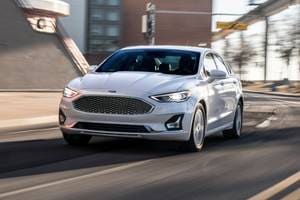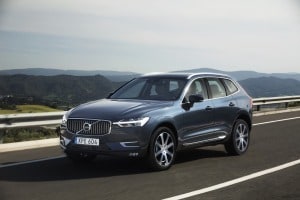Edmunds.com Reports True Cost of Incentives: Highest December Incentives on Record, Remarkable Jump in Leasing Activity
FOR IMMEDIATE RELEASE
Edmunds.com Reports True Cost of Incentives: Highest December Incentives on Record, Remarkable Jump in Leasing Activity
SANTA MONICA, Calif. — January 5, 2009 — Edmunds.com, the premier online resource for automotive information, estimated today that the average automotive manufacturer incentive in the U.S. was $2,902 per vehicle sold in December 2008, up $221, or 8.2 percent, from November 2008, and up $443, or 18.0 percent, from December 2007.
"Never before has the December average incentive been this high," stated Jesse Toprak, Executive Director of Industry Analysis for Edmunds.com. "Automakers have been pulling out all the stops to keep motivating shoppers during these tough times."
According to Edmunds.com, combined incentives spending for domestic manufacturers averaged $3,778 per vehicle sold in December 2008, up from $3,554 in November 2008. From November 2008 to December 2008, European automakers increased incentives spending by $451 to $2,963 per vehicle sold; Japanese automakers increased incentives spending by $57 to $1,738 per vehicle sold; and Korean automakers decreased incentives spending by $141 to $2,466 per vehicle sold.
| True Cost of Incentives for "Big Six" Automakers | |||
|---|---|---|---|
| Automaker | December 2008 | November 2008 | December 2007 |
| Chrysler Group | $3,667 | $3,514 | $3,283 |
| Ford | $4,029* | $3,818 | $3,919 |
| General Motors | $3,661 | $3,350 | $3,490 |
| Honda | $1,218 | $1,115 | $1,031 |
| Nissan | $2,251 | $1,248 | $2,065 |
| Toyota | $1,995 | $2,005* | $1,067 |
* Denotes a monthly record for the indicated automaker.
In December 2008, the industry's aggregate incentive spending is estimated to have totaled approximately $2.5 billion, up 23.8 percent from November 2008. Chrysler, Ford and General Motors spent an aggregate of $1.6 billion, or 65.4 percent of the total; Japanese manufacturers spent $536 million, or 21.7 percent; European manufacturers spent $232 million, or 9.4 percent; and Korean manufacturers spent $89 million, or 3.6 percent.
"No automaker and no market segment has been immune to the economic fallout," commented Edmunds' AutoObserver.com Senior Editor Michelle Krebs. "Total unit sales remain pathetic compared to original expectations, incentives on SUVs and trucks are at record levels even though gas prices are below two dollars per gallon, and Toyota incentives are double what they were this time last year."
Among vehicle segments, premium luxury cars had the highest average incentives, $6,601 per vehicle sold, followed by large trucks at $5,434. Subcompact cars had the lowest average incentives per vehicle sold, $482, followed by compact cars at $1,194. Analysis of incentives expenditures as a percentage of average sticker price for each segment shows large trucks averaged the highest, 16.5 percent, followed by large cars at 11.8 percent of sticker price. Subcompact cars averaged the lowest with 3.0 percent and sport cars followed with 4.5 percent of sticker price.
Comparing all brands, in December MINI spent virtually nothing followed by Scion at $145 per vehicle sold. At the other end of the spectrum, Lincoln spent the most, $5,975, followed by SAAB at $5,508 per vehicle sold. Relative to their vehicle prices, Mercury and Jeep spent the most, 15.4 percent and 15.2 percent of sticker price, respectively; while MINI spent virtually nothing and Scion spent 0.9 percent.
Interestingly, leasing has become more popular since the financial industry collapse in September. Before the implosion, leasing represented only10 percent of total new car sales, the lowest level in recent history. In December, leasing represented about 13 percent of all new car sales, and was close to or more than 50 percent for luxury brands such as Audi, BMW, Infiniti and Mercedes-Benz.
"Luxury automakers are finding their best success in marketing low lease rates now that consumers are very conscious of their monthly expenses," observed Toprak. "Leasing allows consumers to get a lot of car for the money with no long term commitment, and that is a very desirable proposition in today's economy."
Edmunds.com's monthly True Cost of IncentivesSM (TCISM) report takes into account all automakers' various U.S. incentives programs, including subvented interest rates and lease programs, as well as cash rebates to consumers and dealers. To ensure the greatest possible accuracy, Edmunds.com bases its calculations on sales volume, including the mix of vehicle makes and models for each month, as well as on the proportion of vehicles for which each type of incentive was used.
About Edmunds
Edmunds publishes four Web sites that empower, engage and educate automotive consumers, enthusiasts and insiders. Edmunds.com, the premier online resource for automotive consumer information, launched in 1995 as the first automotive information Web site. Its most popular feature, the Edmunds.com True Market Value®, is relied upon by millions of people seeking current transaction prices for new and used vehicles. Edmunds.com was named "Best Car Research Site" by Forbes ASAP, has been selected by consumers as the "Most Useful Web Site" according to every J.D. Power and Associates New Autoshopper.com Study(SM), was ranked first in the Survey of Car-Shopping Web Sites by The Wall Street Journal and was rated "#1" in Keynote's study of third-party automotive Web sites. Edmunds is headquartered in Santa Monica, California, and maintains a satellite office in suburban Detroit.








